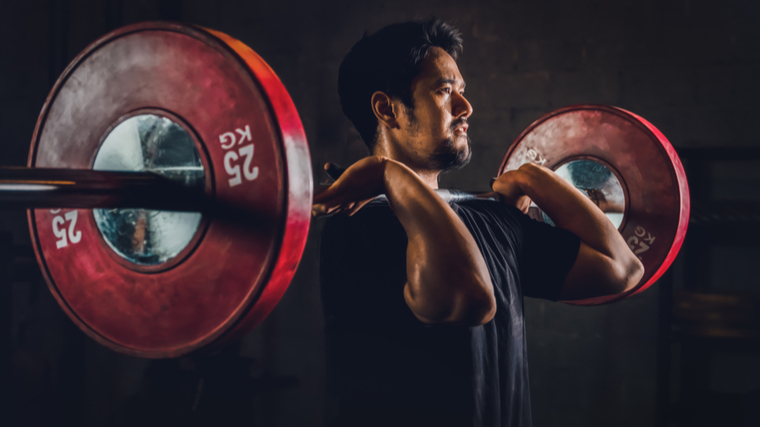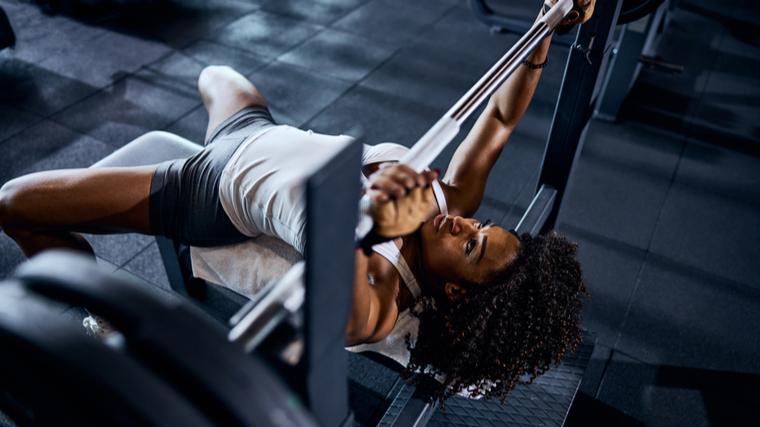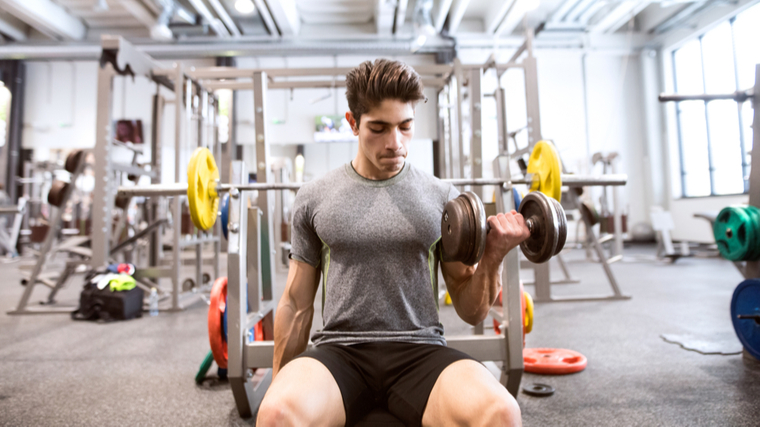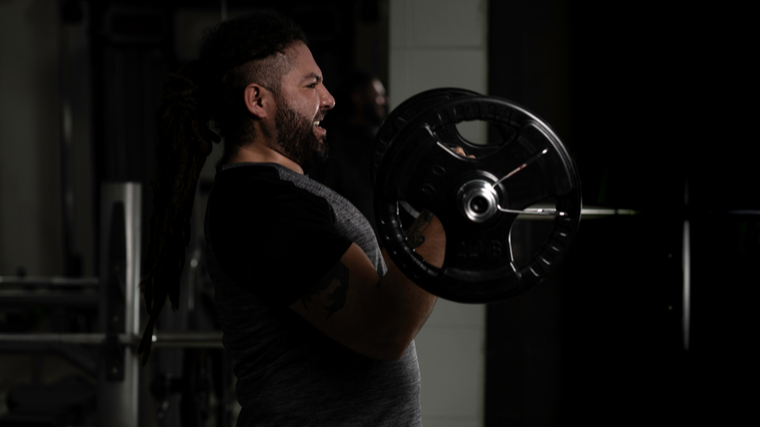Sometimes you’re training mainly to get strong. Other times, your primary focus is on gaining muscle mass. And still, other times, you want the best of both worlds — to lift heavy and build muscle. Enter the wide world of powerbuilding programs.
Over the years, powerbuilding has become a prevalent training style for recreational lifters everywhere. The term powerbuilding earns its name because it combines training elements from powerlifting and bodybuilding programs. Powerlifters focus on lifting max weight. For bodybuilders, developing a muscular physique is the primary goal. When combining the two into powerbuilding, you end up with a program that can get you strong and muscular.

The art of training for both strength and aesthetics is nothing new in strength training, but the term powerbuilding has created a brand new subset of training ideologies. This article will tell you all about the significant benefits of powerbuilding programs. You’ll also learn about the difference between powerlifting and bodybuilding programs, what powerbuilding programs are, and what types of lifters can benefit from them most.
Benefits of Powerbuilding Programs
- Multi-Goal Approach
- Curate Your Accessories
- Bridge to Finding a Sport
- Introduction to Periodization
- Get Strong and Build Muscle
- Keep You Motivated
- Bust Through Plateaus
- Increase Mental Focus
Multi-Goal Approach
Potentially the most significant benefit of powerbuilding programs is how they combine multiple goals into one cohesive lifting agenda. Every strength training program will improve strength, hypertrophy, muscular endurance, and power to some degree. But powerbuilding programs place a heavy emphasis on multiple goals at once.
This multi-goal approach may not be the fastest way to build muscle or strength strictly. But if your overall goal is to focus on a few areas at once, powerbuilding programs can be an excellent fit for you.
Curate Your Accessories
Any program worth its weight in kettlebells contains accessory work. But accessory work, as the name implies, is meant to be tailored toward a specific goal. Because powerbuilding is more obscure, you have more freedom to select accessories that otherwise wouldn’t fit into solely a bodybuilding or powerlifting program.
Powerlifting programs, for example, are purely meant to increase strength. Any accessory movement is programmed to bolster your prowess in the bench press, back squat, and deadlift. In the same vein, bodybuilding accessory work targets specific portions of specific muscles for complete development.
However, if you follow a powerbuilding program, there’s more freedom to pick accessory movements based on what you want and not necessarily what you need. At the same time, a powerlifter will rarely ever program cable chest flyes over a compound movement like the JM Press into their routine, you can — especially if chest mass is the goal.
And that’s how powerbuilding is typically structured — you train like a powerlifter for the first couple of compound movements for strength. Then you channel your inner bodybuilder and build muscle with more focused isolation movements.
Bridge to Finding a Sport
Powerbuilding programs can be a good bridge to finding your preferred strength sport. Often, recreational lifters want to get stronger and improve their lean muscle mass. But you might not have a strong desire to pursue powerlifting or bodybuilding.
Powerbuilding programs expose you to both training styles at once. As a result, you’ll be able to assess both sports and your potential to succeed in one or the other. Many athletes will find that they respond best to a particular form of training — and powerbuilding can put you on the path to pursuing one sport more seriously.
Introduction to Periodization
For beginners or even experienced lifters who haven’t followed a specific program before, powerbuilding can introduce you to periodized training styles. Based on your goals and needs, powerbuilding programs periodize the main compound movements and muscle-building accessories.
This training structure takes a major piece of the workout — compound lifts and accessory lifts — and teaches the concept of periodization. Because powerbuilding programs are less specific than the programs that they’re bridging, you won’t be overwhelmed by periodizing progress for every movement separately if you’re new to the concept.
Get Strong and Build Muscle
Both powerlifting and bodybuilding programs can get you strong and lean, especially if you’re benefiting from those sweet newbie gains. But powerbuilding is focused on gaining strength and developing muscular aesthetics. As a result, these programs are uniquely suited to athletes who love to lift heavy and want to build muscle.

Powerbuilding lets you switch up your focus within the same program and cycle so you can get the best of both worlds. For example, two workouts in a week can have a heavy focus on strength, while two can have a large focus on hypertrophy.
Think of powerbuilding as a sliding scale. At any point, you can shift your efforts more toward bodybuilding or powerlifting depending on your personal goals.
Keep You Motivated
All three types of programs — powerlifting, bodybuilding, and powerbuilding — require a great degree of mental discipline. But powerbuilding programs can offer more training and different kinds of discipline to focus on.
One day, you might be focused on squatting very heavy. The next day, you’ll require all your focus for a tempo-based upper body workout. This undulating focus might be what you need to keep you motivated.
Powerbuilding can also boost your motivation levels to follow a program that directly addresses more than one goal at a time. You might be deadlifting multiple plates but stressed and sad about the size of your arms. Or you may find yourself envying those folks lifting heavy while you’re focusing on hypertrophy work. Powerbuilding allows you to do both, which can keep you motivated to continue lifting.
Bust Through Plateaus
If you’ve been powerlifting for a long time and have hit plateaus, incorporating bodybuilding techniques may help boost your numbers. You’ll be strengthening your smaller muscle groups and paying more attention to factors like form and time under tension. As a result, you’re very likely to strengthen weak points that may have been hindering your powerlifting progress.
Similarly, if you’re a long-time bodybuilder, incorporating aspects of powerlifting can boost your overall strength. And when you’re stronger, you can move more weight during your hypertrophy-focused workouts. That can yield much more effective muscle growth which might have been eluding you before you focused on strength, too.
Increase Mental Focus
Too often, powerlifters might not pay attention to the little things that bodybuilders tend to. Bodybuilders often concentrate on slow, high-quality reps, time under tension, and mind-muscle connection. On the other hand, powerlifters are concerned with moving a ton of weight. Incorporating bodybuilding techniques into their program can encourage a traditional powerlifter to move with more intention.
That’s not to say that bodybuilders can’t also benefit from powerlifters’ points of view. You need an incredible amount of mental focus, discipline, and fearlessness to train to lift maximum weights. While your muscles might feel the pump and mind-muscle connection when you’re doing bicep curls, squatting very heavy weights requires a different type of concentration. Developing this elite focus can allow traditional bodybuilders to go heavier — and ultimately develop more muscle.
Powerlifting Vs. Bodybuilding Programs
There is a lot of nuance in both bodybuilding and powerlifting programs. But in general, when you think of powerlifting programs, you generally think of strength. With bodybuilding programs, you generally think of aesthetics. But what are the nitty-gritty, day-to-day differences between the two?
Similarities Between Powerlifting and Bodybuilding Programs
Bodybuilding and powerlifting programs might have different end goals, but they share the same methodologies. Both types of athletes need periodized programs and focused on progressive overload. This means that both programs require you to make consistent, gradual adjustments to your training stimuli. Maybe your training cycle involves slightly increasing your volume or using a slightly heavier weight each week. This way, your workouts won’t become stagnant, and your gains won’t suffer.
Both volume and intensity are crucial to powerlifting and bodybuilding programs. The underlying goals might be different, but these training factors are essential in both programs. And although discipline is typically more associated with bodybuilding, both programs require a lot of discipline to work effectively.
Differences Between Powerlifting and Bodybuilding Programs
Success in powerlifting is based on performance at three lifts: the squat, bench press, and deadlift. Bodybuilding as a sport focuses on physique, muscle quality, and symmetry. Because of this, powerlifters mainly focus on getting strong while bodybuilders look to build muscle. That means that powerlifting trains you in specific movement patterns — for three lifts in particular — while bodybuilding programs focus on training your muscles rather than a particular exercise.
Bodybuilding workouts will tend to focus on muscle groups rather than a competition lift. As opposed to squat day — a powerlifting day focused mainly on the back squat and only a few accessories. Bodybuilders may have a lower body day with many accessory lifts. And while powerlifters may have cycles that focus on increasing their time under tension for muscle growth, that technique is a bodybuilder’s bread and butter.
Why Combine the Two Training Styles?
There are amazing things to be found in powerlifting and bodybuilding programs. Why mess with what works? Well, you might want both strength and aesthetics as a primary focus in training without having to settle for one or the other.

If you’re starting from scratch, you’ll build some muscle while powerlifting. You’ll also develop strength while bodybuilding. But with powerbuilding, you can gain serious strength while building a solid amount of quality muscle. To make the most progress, you’ll likely still have a primary goal: a powerbuilding program with an emphasis on strengthening the compound lifts, for example. You could also have a powerbuilding program with a focus on gaining muscle. In both versions, you’ll make great strides on both fronts.
What Are Powerbuilding Programs?
Once you’ve got a firm idea of the fundamentals of powerlifting and bodybuilding programs, you can practice combining the two. These programs will be less specific and incorporate a training structure tailored to providing multiple goals.
Even though they’re less specific, powerbuilding programs are still designed to help you improve your compound lifts and increase lean muscle mass. As opposed to building workouts based on a movement or a muscle group, powerbuilding programs will combine both methods and structure workouts accordingly. Workouts are typically built around strengthening compound movements. Then, accessories are added to build the muscle groups that assist with that compound.
The main difference between powerbuilding programs and bodybuilding or powerlifting is the intent you are lifting. As opposed to fully focusing on one overall goal for a sport, powerbuilding is the culmination of multiple goals into one slightly less specific program. Because it’s less specific, powerbuilding programs will likely build strength slower than a powerlifting program. Similarly, you’re likely to build muscle slower than on a bodybuilding program. But you will be gaining significant ground toward both goals at once.
Who Should Do Powerbuilding Programs?
As with most programs, many different athletes can benefit from this program style. One way to assess who these programs will work best is to consider what someone’s goals and experience levels are.
Off-Season Powerlifters
If your goal is to compete and excel in either powerlifting or bodybuilding, then following a specific program for that sport will always fare best — especially when competitions are coming up.

But off-season training is a different story. As a powerlifter not in competition prep, you might want to build more muscle mass — while still gaining strength. With a more solid base of muscle mass to work with, you’ll be able to lift heavier when you go back to strict strength training.
Off-Season Bodybuilders
Similarly, focusing a little more on building strength — while also growing muscle — can benefit off-season bodybuilders. The stronger you are, the more weight you can move when you go back to strict hypertrophy training. And the more you can challenge your muscles, the more you can make them grow quality muscle mass.
Recreational Lifters
If you don’t plan to compete but are still dedicated to your training, powerbuilding can diversify your program and keep you focused. You’ll be able to gain both muscle mass and strength simultaneously, which are the primary goals of many athletes. The diversity of what you’ll be doing in the gym can also keep you coming back.
Many times, recreational and casual powerlifters want to get strong and want to improve their lean muscle mass. As a result, these folks are perfect candidates for powerbuilding programs. Recreational lifters might also like to program hop. If that’s the case, you might shift training goals relatively frequently. Because powerbuilding programs entail a multi-directional goal approach, you might be better able to stick with these programs long-term.
Wrapping Up
If you have overall training goals to improve strength and build muscle, then powerbuilding programs might be your new favorite training option. These programs can help you bust through plateaus, introduce you to training periodization, and help you get the best of both worlds from bodybuilding and powerlifting.
Featured Image: Halfpoint / Shutterstock